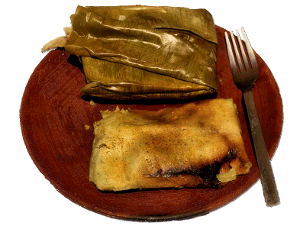Tamale
Introduction
Tamale, also known as "to'lnaa" in the local Dagbani language, is a traditional dish from the Northern Region of Ghana, West Africa. It is a savory steamed dish made from ground cornmeal, typically served with a spicy pepper sauce and often accompanied by vegetables or protein.
History
Tamale has been a staple food in the Northern Region of Ghana for centuries, and its origins can be traced back to the indigenous tribes that lived in the area. The dish was traditionally prepared by grinding dried corn and mixing it with water to create a dough, which was then shaped into balls and steamed in a pot. Over time, the recipe evolved to include other ingredients such as spices and vegetables.
Today, tamale is enjoyed throughout Ghana and other West African countries, as well as in African diaspora communities around the world.
Preparation
To prepare tamale, the cornmeal is first mixed with water to create a dough. This dough is then seasoned with a mixture of spices, which can include garlic, ginger, cumin, and chili powder, among others. The dough is then wrapped in banana leaves or corn husks and steamed until fully cooked.
Tamale is often served with a spicy pepper sauce made from chili peppers, onions, and tomatoes, as well as a variety of other accompaniments such as fried plantains, beans, or grilled meat.
Variations
There are many different variations of tamale throughout West Africa, each with its own unique flavor and preparation method. In Nigeria, for example, a similar dish is known as "moi moi," which is made with black-eyed peas instead of cornmeal. In Mexico, tamales are a popular dish made from masa (a type of corn dough) and stuffed with a variety of fillings such as meat, cheese, or vegetables.
Cultural Significance
Tamale is an important cultural symbol in Ghana and is often served at special occasions such as weddings, funerals, and religious festivals. The dish is also commonly sold by street vendors and is a popular snack food throughout the region.
Regional Variations
While tamale is a popular dish throughout the Northern Region of Ghana, there are some regional variations in preparation and ingredients. In the Dagomba culture, for example, tamale is often made with millet flour instead of cornmeal, giving it a slightly different taste and texture. In the Gonja culture, the dish is often prepared with groundnuts and smoked fish, adding a rich and savory flavor to the dish.
Health Benefits
Tamale is a nutritious and filling dish that provides a range of health benefits. Cornmeal, the primary ingredient in tamale, is a good source of carbohydrates and fiber, and also contains essential vitamins and minerals such as iron, magnesium, and phosphorus. Additionally, the spices used in tamale such as ginger and garlic have anti-inflammatory properties and may help to boost the immune system.
Serving Suggestions
Tamale can be enjoyed as a main dish or as a snack food, and is typically served hot or warm. It pairs well with a range of accompaniments such as grilled chicken or fish, fried plantains, and a variety of vegetables. The spicy pepper sauce traditionally served with tamale can be adjusted to suit individual tastes, with additional chili peppers added for those who prefer a spicier flavor.
Conclusion
Tamale is a flavorful and filling dish that has been enjoyed in West Africa for centuries. Whether served at special occasions or enjoyed as a street food snack, tamale remains an important part of Ghanaian culture and cuisine. With its nutritious ingredients and versatile flavor, tamale is a dish that is sure to continue to be enjoyed for generations to come.
References
Nutritional information on Tamale
|
|
| Food Portal | Food | Nutrition | Diet | Keto | Glycemic index |
NB:Carbohydrate, by difference(total carbs-fiber) is also called net carbs
Search WikiMD
Ad.Tired of being Overweight? Try W8MD's NYC physician weight loss.
Semaglutide (Ozempic / Wegovy and Tirzepatide (Mounjaro / Zepbound) available. Call 718 946 5500.
Advertise on WikiMD
|
WikiMD's Wellness Encyclopedia |
| Let Food Be Thy Medicine Medicine Thy Food - Hippocrates |
Translate this page: - East Asian
中文,
日本,
한국어,
South Asian
हिन्दी,
தமிழ்,
తెలుగు,
Urdu,
ಕನ್ನಡ,
Southeast Asian
Indonesian,
Vietnamese,
Thai,
မြန်မာဘာသာ,
বাংলা
European
español,
Deutsch,
français,
Greek,
português do Brasil,
polski,
română,
русский,
Nederlands,
norsk,
svenska,
suomi,
Italian
Middle Eastern & African
عربى,
Turkish,
Persian,
Hebrew,
Afrikaans,
isiZulu,
Kiswahili,
Other
Bulgarian,
Hungarian,
Czech,
Swedish,
മലയാളം,
मराठी,
ਪੰਜਾਬੀ,
ગુજરાતી,
Portuguese,
Ukrainian
Medical Disclaimer: WikiMD is not a substitute for professional medical advice. The information on WikiMD is provided as an information resource only, may be incorrect, outdated or misleading, and is not to be used or relied on for any diagnostic or treatment purposes. Please consult your health care provider before making any healthcare decisions or for guidance about a specific medical condition. WikiMD expressly disclaims responsibility, and shall have no liability, for any damages, loss, injury, or liability whatsoever suffered as a result of your reliance on the information contained in this site. By visiting this site you agree to the foregoing terms and conditions, which may from time to time be changed or supplemented by WikiMD. If you do not agree to the foregoing terms and conditions, you should not enter or use this site. See full disclaimer.
Credits:Most images are courtesy of Wikimedia commons, and templates, categories Wikipedia, licensed under CC BY SA or similar.
Contributors: Kondreddy Naveen



